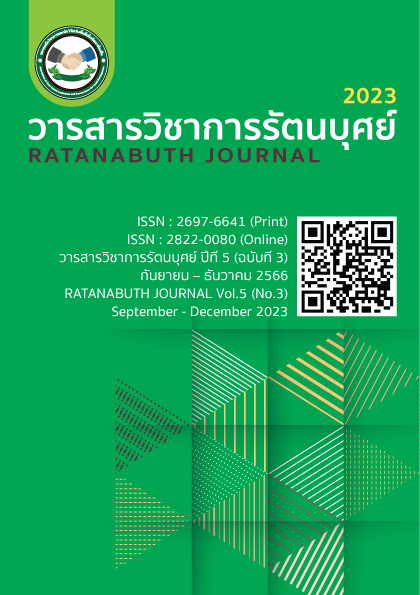The Development Guidelines for Teacher in Learning Management for 21st Century for Schools Under The Maha Sarakham Primary Education Service Area Office 1 The Development Guidelines for Teacher in Learning Management for 21st Century for Schools Under The Maha Sarakham Primary Education Service Area Office 1
Main Article Content
Abstract
The objectives of this research were to: 1)Study the current conditions, desirable condition and need assessment of developing teacher in learning management for 21st century for schools under the Maha Sarakham primary education service area office 1 2)Study the development guidelines teacher in learning management for 21st century for schools under the Maha Sarakham primary education service area office 1. The research was divided into four phases as follow; phase 1; study the current conditions, desirable condition and need assessment of developing teacher in learning management for 21st century. The sample group were 297 school administrators and teachers, The research instrument was questionnaire, confidence of the whole questionnaire .84. phase 2; study the development guidelines for teacher in learning management for 21st century. The target groups include 3 school for visiting best practices and 7 experts to study and evaluate the guidelines. The research tool was interview form, Data analysis by content analysis.
The results found that:
1) The current state in overall was high average and the desirable state in overall was in the highest level. The need assessment rank from high to low level was 1) Assessment for learning 2) Child-centered learning 3) Integrated learning 4) Technology base Learning.
2) The development guidelines teacher in learning management for 21st century comprised of 1) Assessment for aptitude, learning outcomes and skills of learners 2) Assessment for learning development 3) Analytical, synthesis thinking and problem-solving skill 4) Self-Learning skill 5) Integrated learning 6) Integrated Knowledge to living 7) Technology base Learning and 8) Design and development of work using technology.
Article Details

This work is licensed under a Creative Commons Attribution-NonCommercial-NoDerivatives 4.0 International License.
References
กระทรวงศึกษาธิการ. (2560). แผนการศึกษาแห่งชาติ พ.ศ. 2560-2579. กรุงเทพฯ : สำนักงานเลขาธิการสภาการศึกษา.
ทิศนา แขมมณี. (2555). ศาสตร์การสอน. พิมพ์ครั้งที่ 16. กรุงเทพฯ: โรงพิมพ์แห่งจุฬาลงกรณ์มหาวิทยาลัย.
ธีระ รุญเจริญและวาสนา ศรีไพโรจน์. (2554). กลยุทธ์การพัฒนาความเป็นบุคคลแห่งการเรียนรู้. กรุงเทพฯ:ข้าวฟ่าง.
บัณฑิต เอื้ออาภรณ์. (2557). ขอบแดนใหม่แห่งการเรียนรู้ : การศึกษาระบบ 4.0 (New Frontier of Learning : Education 4.0). กรุงเทพฯ : ศูนย์นวัตกรรมการเรียนรู้จุฬาลงกรณ์มหาวิทยาลัย.
บุญชม ศรีสะอาด. (2556). การวิจัยเบื้องต้น. พิมพ์ครั้งที่ 9. กรุงเทพฯ: สุวีริยาสาส์น.
พิมพันธ์ เดชะคุปต์. (2555). สอนเขียนแผนบูรณาการบนฐานเด็กเป็นสำคัญ. กรุงเทพฯ: โรงพิมพ์แห่งจุฬาลงกรณ์มหาวิทยาลัย.
พิมพันธ์ เดชะคุปต์และพเยาว์ ยินดีสุข. (2558). การจัดการเรียนรู้แนวในศตวรรษที่ 21. พิมพ์ครั้งที่ 3. กรุงเทพฯ: โรงพิมพ์แห่งจุฬาลงกรณ์มหาวิทยาลัย.
ไพฑูรย์ สินลารัตน์. (2560). การศึกษา 4.0 เป็นยิ่งกว่าการศึกษา. พิมพ์ครั้งที่ 4. กรุงเทพฯ : โรงพิมพ์แห่งจุฬาลงกรณ์มหาวิทยาลัย.
ฟาฏินา วงศ์เลขา. (2558). การจัดการเรียนการสอนในโลกยุคดิจิทัล. สืบค้นเมื่อ 25 ตุลาคม 2565 จาก http://www.moe.go.th/moe/th/news/detail.php?NewsID=43633&Key=hotnew.
ภาสกร เรืองรองและคณะ.(2557). เทคโนโลยีการศึกษากับครูไทยในศตวรรษที่ 21. วารสารปัญญาภิวัฒน์, 5(5), 195-205.
ยืน ภู่วรวรรณ. (2557). บทบาทของครูในยุคดิจิตอล.สืบค้นเมื่อ 25 ตุลาคม 2565 จาก https://www.facebook.com /people/ยืน-ภู่วรวรรณ/1162233576.
วิจารณ์ พานิช. (2555). วิถีสร้างการเรียนรู้เพื่อศิษย์ในศตวรรษที่ 21. กรุงเทพฯ: มูลนิธิสดศรี-สฤษดิวงศ์.
ศศิธร เวียงวะลัย. (2556). การจัดการเรียนรู้. กรุงเทพฯ: โอเดียนสโตร์.
สิริพัชร์ เจษฎาวิโรจน์. (2559). การพัฒนาหลักสูตรสถานศึกษา = Development of school curriculum. กรุงเทพฯ: มหาวิทยาลัยรามคำแหง.
สุมน อมรวิวัฒน์. (2560). ครุศึกษากับความเปลี่ยนแปลงที่ท้าทาย. กรุงเทพฯ: โรงพิมพ์พัชรินทร์ พี.พี.
สุวิมล ว่องวาณิช. (2558). การวิจัยประเมินความต้องการจำเป็น. กรุงเทพฯ: สำนักพิมพ์แห่งจุฬาลงกรณ์มหาวิทยาลัย.
สำนักบริหารงานการมัธยมศึกษาตอนปลาย. (2560). แนวทางการจัดทักษะการเรียนรู้ในศตวรรษที่ 21 ที่เน้นสมรรถนะสาขาวิชาชีพ. สืบค้นเมื่อ 15 ธันวาคม 2565 จาก http://www. Sesarea 23.go.th/web/ news_file/p33993121042.pdf.
สำนักงานเลขาธิการสภาการศึกษา.(2557). รายงานการวิจัยแนวทางการพัฒนาการศึกษาไทยกับการเตรียมความพรอมศตวรรษที่ 21. กรุงเทพฯ: สำนักงานเลขาธิการสภาการศึกษา กระทรวงศึกษาธิการ.
สำนักงานเลขาธิการสภาการศึกษา.(2558). รายงานสภาวะการศึกษาไทย ปี 2557/2558 จะปฏิรูปการศึกษาไทยให้ทันโลกในศตวรรษที่ 21 ได้อย่างไร. กรุงเทพฯ: สำนักงานเลขาธิการสภาการศึกษา กระทรวงศึกษาธิการ.
สำนักงานเลขาธิการสภาการศึกษา.(2560). แผนการศึกษาแห่งชาติ พ.ศ. 2560-2579. กรุงเทพฯ: พริกหวานกราฟฟิค.
สำนักงานเลขาธิการสภาการศึกษา.(2565). รายงานสภาวการณ์คุณภาพการศึกษาปี 2563-2564. กรุงเทพฯ: 21 เซ็นจูรี่.
Kay, K. (2018). 21st century skills: Why they matter, what they are, and how we get there. In Bellanca, J., & Brandt, R. (Eds.), 21st century skills: Rethinking how students learn. Bloomington, IN: Solution Tree Press.
Krejcie, R. V. & Morgan, D. W. (1970). Determining Sample Size for Research Activities. Educational and Psychological Measurement, 30(3), p. 607-610.
Kyriacou, Chris. (2007). Essential Teaching Skills. United Kingdom: Nelson.
Martin, J. (2010). The meaning of the 21st century. Bangkok, Inc.

